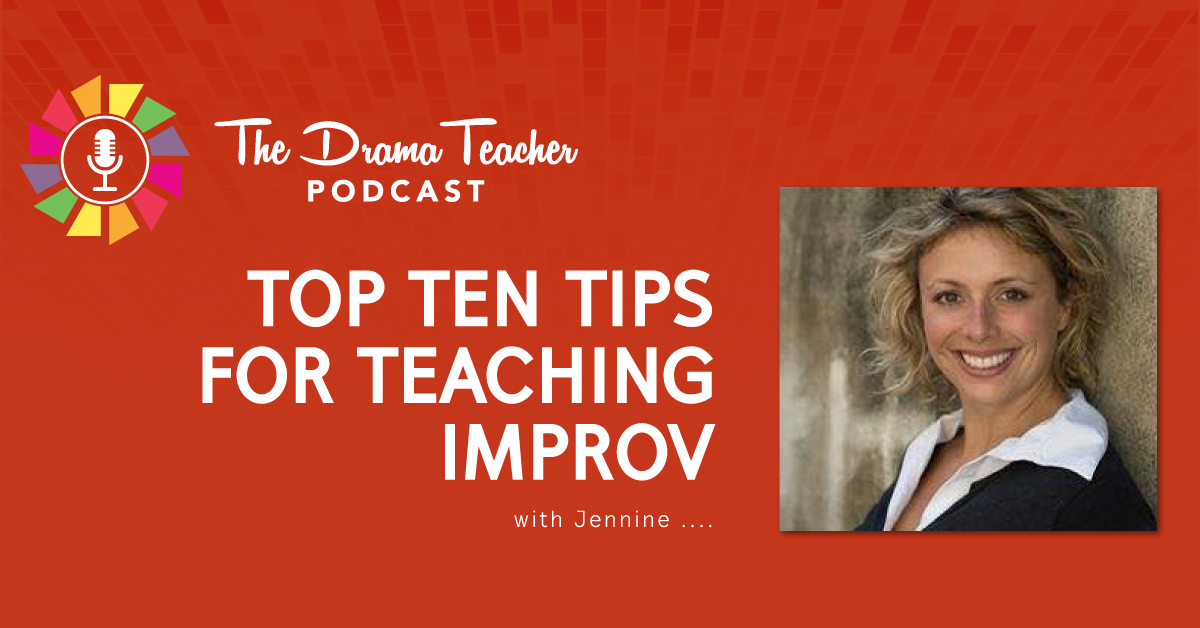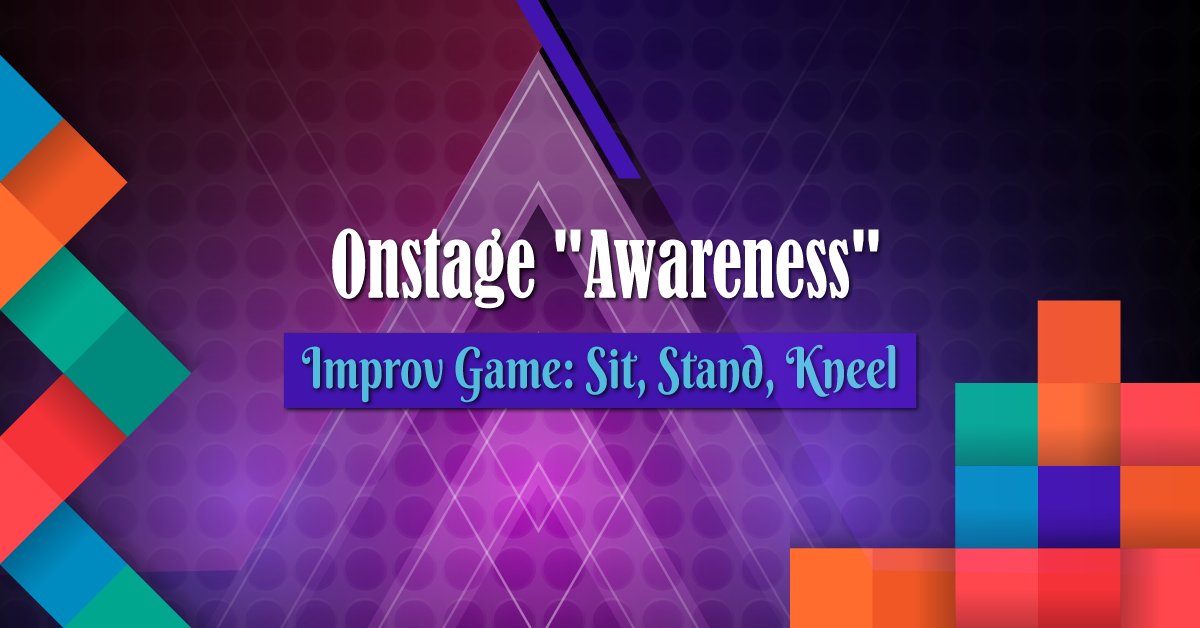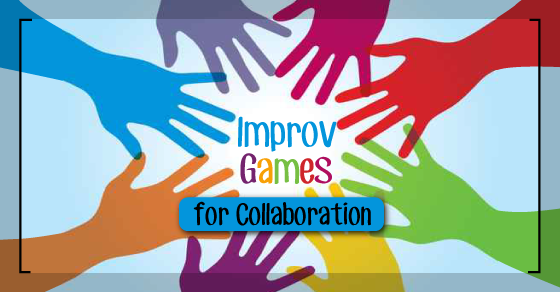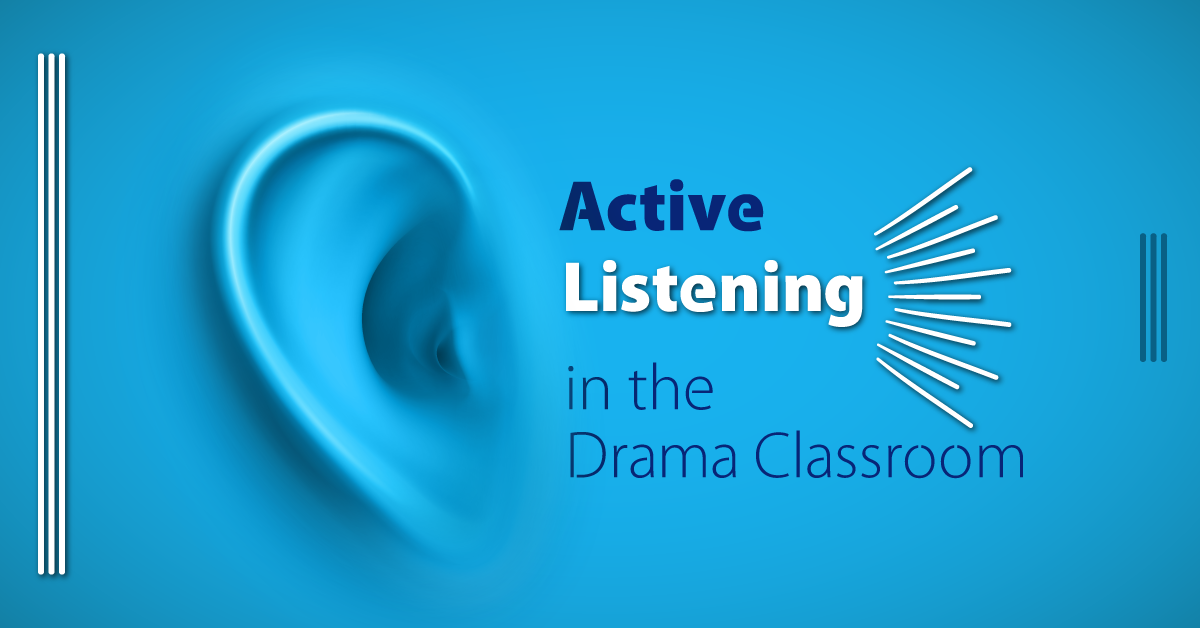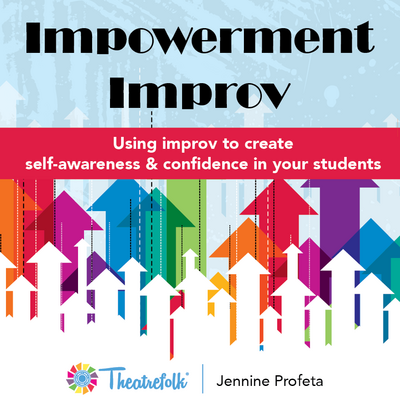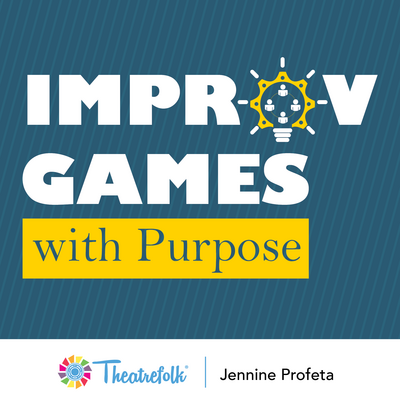Horror Movie 101: Failing Can Be Deadly by Steven Stack is a chilling mix of horror and humor - perfect for student performers and the spooky season! 👻
Top Ten Tips For Teaching Improv
Episode 136: Top Ten Tips For Teaching Improv
Improvisation! Every student loves it, but does every teacher? Improv is one of those things that looks so easy but the tide can turn easily. When you have students who do nothing but try to be funny, and others who refuse to join one scene, it can get frustrating quickly. Listen in to hear Second City performer and long time teacher Jennine Profeta shares her top ten tips for teaching Improv.
Show Notes
Drama Teacher Academy Course: Yes, And… How to Teach Improv
Episode Transcript
Welcome to TFP – The Theatrefolk Podcast – the place to be for Drama teachers, Drama students, and theatre educators everywhere.
I’m Lindsay Price, resident playwright for Theatrefolk.
Hello! I hope you’re well. Thanks for listening.
Welcome to Episode 136!
You can find any links for this episode in the show notes – theatrefolk.com/episode136.
Okay. Today, we are talking improvisation which might be the highlight or the bane of your existence, right? I think that’s where improv lands. Nobody’s like “meh!” on improv. They either love it and they love teaching it and it’s a part of their class or they hate teaching it and they hate that their students are always begging for those improv games – because every student wants to play improv games!
But what if you don’t like it? What if you don’t have experience? You know that you should include it but you’re not sure what path to take? And what if it always goes wrong?
Improv is one of those things that looks so easy and so effortless by those who do it well. And the fact of the matter is that it’s not easy and it’s not effortless and you also have students who try to maneuver situations – they’re always trying to be funny. And then, what about the other students who refuse to even join in because they’re so terrified of improv? I can relate to that a thousand percent.
It all can get frustrating really quickly. Let’s try to solve that here today. Right; we’re going to solve all your improv problems – okay, maybe not! We’ll have a nice… you can listen to a nice chat with a wonderful improv performer and teacher and a long-time friend. I have known Jeanine Profeta… I think we talk about how long we’ve known each other so I’ll leave that for the actual interview but she is a Second City instructor and Jeanine is on the podcast today.
We are talking tips for teaching improv. Let’s get to it!
LINDSAY: Hello! I am tickled pink and coming up roses that I get to introduce this podcast guest, Jeanine Profeta. Hello, Jeanine!
JEANINE: Hello, Lindsay!
LINDSAY: Jeanine, we are sitting here in the posh surroundings known as the Second City Training Centre in Toronto.
JEANINE: Yeah.
LINDSAY: Let me describe the scene for you. We’re in a basement and the walls are plywood. Can you please tell me why the walls are plywood?
JEANINE: Yes, the walls are plywood because many a student has put a fist through the wall, enthusiastically. No, it’s for real! People get all excited and limbs go flailing. At one point, there were so many holes in the wall so, yeah, they just put the plywood to stop them. Now, it’s all just broken knuckles and tears.
LINDSAY: Well, this is the perfect segue into our topic which is we’re going to be talking improv. I did not expect that answer and I love that answer – that people get so excited to do improv that they put holes in the walls.
So, Jeanine, we have known each other…
JEANINE: Ugh, don’t say it! Don’t do the math.
LINDSAY: I’m not going to do the math but it’s been a long time.
JEANINE: Yes. You know what, you’ve known me since I did improv badly. I used to do improv on the Fringe circuit with a troop, a bunch of gals, and it was one of those things – we just loved it – but I could never figure out for the life of me what I was doing. But there was a game – like, a bucket game – where you could put your head in a bucket of water. I think that’s what always kept me going even though I sucked at it.
LINDSAY: There you have it, friends. Put your head in a bucket of water. But, yeah, we’re going to talk about improv. Jeanine is – I’m going to say – she is a lifer. You are an improv lifer, aren’t you? You love it and you’ve been doing it for a long time.
JEANINE: I am so in.
LINDSAY: And you don’t see yourself stopping doing it.
JEANINE: No, my husband and I – who’s also an improviser – always talk about, if we won the lottery tomorrow, nothing would change except we’d actually have a house.
LINDSAY: Yes.
JEANINE: We would still do this stuff.
LINDSAY: We’re going to talk about Jeanine’s top ten tips for teaching improv. But, first of all, we’re going to go back a little ways. What was it that initially made you think about doing improv? Like, why improv?
JEANINE: Uh, I think I didn’t know what the heck I was getting myself into. No, way back then, you know, in my babysitting years, I used to watch a lot of Saturday Night Live and a lot of people – and a lot of people who end up here at the training centre – that was my introduction to comedy in general. And then, at some point, I started coming to Toronto, seeing shows at Second City. And then, yeah, there was this crazy magical thing called improv where these very funny people would get a suggestion from the audience and they would just spin gold out of it and I was hooked. I was like, “I want to do that!” Yeah, it was just seeing that stuff – that was my foray into comedy. I’m also terrible at stand-up so I was never going to have a career doing that. Yeah, I think by default is really how I ended up in improv and, yeah, they were willing to take my money and let me take a course.
LINDSAY: So, you have done the gambit. You’ve taught here at Second City going on ten years now.
JEANINE: I told you, no math – oh, gripe!
LINDSAY: Oh, dear! Okay. So, Jeanine has taught at Second City for a long time. You’ve performed, you’ve done the touring company, you’ve performed on main stage…
JEANINE: Well, only as an understudy but yeah.
LINDSAY: I came and saw you so I know you performed on main stage, Ms. Profeta.
JEANINE: They turned the lights on and they let us do our thing so it felt like the main stage.
LINDSAY: You also toured the world with Second City. At your starting point which I find really interesting is that we’ve talked a lot about improv and I’ve seen you do it all these years but you have said, when you started out, that you didn’t like it all that much.
JEANINE: No, not at all. I think I’m totally a masochist actually because I just kept coming back for more but I loved comedy and there was something there and other people were getting it but I wasn’t getting it. I needed to figure out what were those things that would make it work and I think I may have stumbled across a few of those.
LINDSAY: We’re going to go to that in a second. Do you think it was your teachers? Is that why you think you didn’t quite get it back then?
JEANINE: Well, if they’re listening right now, no. But there is a way to teach this stuff and I think, a lot of times, I did have instructors that were teaching so many different things, so many different topics, and there wasn’t sort of that one place you went to learn about improv the same way you would learn about staging a play, for example, or stage management. Yeah, I think the people were doing the best with what they had – with the tools they had which was a list of games and some explanation of how to play them but not necessarily how to play them well.
LINDSAY: Now that you’ve been teaching improv a lot and you’re now on that side of the table, what is it that you like about teaching improv?
JEANINE: I love watching the light bulb go on for the students. I always say my favorite day is the very first day of Level A. Everybody is absolutely terrified. They sit there – some of them still have their coats on – and they’re hugging their purses, arms are crossed, legs are crossed. I do a check-in, most of them will say, “Yeah, I’m terrified to be here,” and then we get up on our feet and we start doing stuff and you just watch the arms go by their side, they put the purse down, they start having fun, and my favorite thing to say to them at the end of like a three-hour class is, “Think back where you were three hours ago when you walked in the door and where you are now and just look at how far you’ve come.” That’s the magic of improv.
LINDSAY: That’s the magic of every teaching moment, I think. I think that’s why people teach – when they can pass that moment along and see the light bulb go off.
We are going to go through Jeanine’s ten top tips for teaching improv. Yes, that’s my lovely alliteration going on there. These are some tools that you can take away when you are in the classroom and just to start thinking about beyond the exercises. It’s one thing to just take an exercise and sort of throw it at your students but there is a way to teach improv, isn’t there? We want to sort of get some of these elements and these principles in your heads.
Let’s go. Tip number one?
JEANINE: Tip #1 – there are no wrong answers. There are no wrong offers. Students are very reticent sometimes to put something on the table. They’re scared that they’re not going to say the perfect thing. Don’t worry about perfect. Just put something out there and know that things are going to spin out from it so just take your partner’s offer, say yes to it, add a little bit, and just see where it goes. If you don’t like your partner’s offer – if they’re giving you not much to work with – finding a way to make it work for yourself.
Yeah, no wrong answers, but sometimes we do have to find a way to work with them.
LINDSAY: Well, I think that’s important because sometimes things come out and they’re not perfect and they’re not what you expected or sometimes you’ve got a partner who’s trying to be the funny one and that is not a great offer so you have to figure out how to make it a great offer.
JEANINE: Absolutely. Actually, right now there are some auditions that are going on and sometimes you get stuck with a really sucky partner and you have, in an audition situation, you’re trying to make yourself look good and I know people have successfully gotten through their auditions by the way they’ve handled working with that partner – that they find a way to make it, like I say, work with them and that is going to get them way more brownie points than anything else that they’re going to do.
LINDSAY: Awesome. Tip number two?
JEANINE: Improv is overwhelming. Oh, gosh, you can just choose from anything in the world and students are afraid that they’re not going to say that perfect thing, that they’re not going to be funny, or they’re not going to be able to contribute anything. We are aware of this and we’re going to address this.
LINDSAY: I think that sometimes everybody thinks that improv is easy and improv is effortless, right?
JEANINE: Yes.
LINDSAY: They see “Whose Line Is It Anyway?” and they can do anything and they just can pick up anything and then these students get into the classroom and they’re like, “Uh…”
JEANINE: Yeah, and I like to remind my students that people like Colin Mochrie and Ryan Stiles have been doing this for decades together. They’re so good working off each other because they’ve been doing it for so long and they’ve stuck with it and that’s the important thing. Stick with it and just keep working at it and see what happens.
LINDSAY: And everything that is overwhelming at the beginning… overwhelming is a thing that you can get over.
JEANINE: Absolutely, yeah.
LINDSAY: Awesome. Tip number three?
JEANINE: Improv is a team sport. We are in it to win together. We’re all friends, we all support each other, we all help each other out. When we do shows, a lot of us have adopted this thing called “I got your back” so we go around and we tap each other on the back and say, “I got your back” because, again, it’s a reminder that it’s a team sport. You are not on the stage alone and, if you are up there alone doing jokes, you’re doing stand-up and we don’t want to do that here.
LINDSAY: I think that’s one of the most important things to remember – that improv works best as a team – and I think about your classroom, about all the skills that we are supposed to be teaching these students these days – collaboration, communication, working together, team building – that’s how you can incorporate improv successfully into your curriculum. How are students working together? How are they working as a team as opposed to making it that “I’m the best, I’m the funniest.”
JEANINE: Yeah, especially those class clowns that are used to getting the laugh and being the star and being the center of attention. We can find ways to work with them and incorporate them but, again, it’s talking about going for the group win. It’s much more satisfying and the audience rewards you more when you succeed together.
LINDSAY: I like that very much. I like that very much – I do. I think that particularly in the classroom situation when there is a lot of insecurity going around. If we can just get people working together, that’s going to go away.
JEANINE: Oh, yeah, I was just going to say, yeah, it’s about just listening to each other and working off of each other rather than feeling alone – like, do we have to do it alone? We have to be funny alone. It’s not about that. It’s collaborative; it’s doing it together.
LINDSAY: Tip number four, please?
JEANINE: Keep physically open. I mentioned this earlier about holding on to the purses. Yeah, students ten to cross their arms, cross their legs. I know I stand in a crossed arm position because it’s comfortable sometimes but it’s also defensive and it shuts us down and actually you’re not really able to listen as well when your body is crossed so I get them to open up – uncross those arms, uncross those legs, and sometimes you have to remind them several times throughout a class until they’re rolling their eyes going, “Oh, here goes teacher again,” but at least they’re listening!
LINDSAY: Do they call you Teacher Profeta? Miss? Teacher Jeanine?
JEANINE: They call me ma’am.
LINDSAY: No, they call you sir. All right, tip number five?
JEANINE: Listening. Yeah, as you pointed out, it’s all about communication and collaboration so, yeah, we need to listen to each other. We need to listen to our scene partners and – I keep talking about this “yes, and…” – say “yes” and build on it. All acting is about reacting and so improv is this in the purest form so you have to be able to listen and to react to your partner. Again, sometimes, if you see those students that are in their own heads, they have an agenda, they’re thinking, “Oh, I’m going to start talking about a unicorn because that’s going to be really funny,” they’re not paying attention what their friend is saying, the audience picks up on that. “Boo!” They don’t like it so much. Yeah, we need to listen and riff off each other and just go back and forth.
LINDSAY: Do you find you get students who sort of try to pre-plan what they’re going to say in a scene?
JEANINE: All the time! I used to do that. That’s where you get yourself in trouble. Like, you’re just so busy writing it. “Okay, I’m going to do this and then I’ going to expect my partner to do this.” Sometimes, in the feedback, they identify that. It’s like, “Well, she didn’t react the way she was supposed to.” It’s like, “Well, no, how can you know what your friend is going to do?” You have to leave yourself open and just see what they do and then be ready to jump on that.
LINDSAY: Fabulous. All right. So, one to five, we have that there is no wrong answers, improv is overwhelming – I believe that 100 percent that improv is very overwhelming for me.
JEANINE: I can make you an improv star!
LINDSAY: Oh, I know that! I know that for sure! Improv is a team sport. Keep physically open and listen, listen, listen! Listen to what we’re saying. Improv is listening. Okay. So, that’s one to five. Now, let’s go on to tip number six.
JEANINE: Yeah, when I’m giving students my feedback, I like to focus on the wins and the challenges as opposed to what is right and wrong because everybody gets in their head about what’s perfect, what’s the right thing to say – like, society does this to us, right? Let’s just get away from that because none of us are ever going to be perfect. Yeah, let’s just focus on the wins. Again, that idea that there is no wrong in improv as long as we’re listening to each other and supporting each other, everything that we say, everything we’re contributing is going to take us into a good place.
And I like to have the students self-identify a lot – what’s working for them and what’s not working – because they’ll have it on their brains. It’s like, “Yeah, I didn’t know what to say in this scene,” then that’s a chance for me to say, “Yeah, I was kind of feeling like you didn’t know what to contribute. Were you listening to what your partner was saying or were you just trying to pre-plan? Maybe that was the problem you were having. Maybe next time we’ll try not to do that so that you have a better time.”
LINDSAY: Yeah, here’s another great point. If you are trying to figure out how you can evaluate your students when you’re doing improv, how are we supposed to take this thing that doesn’t exist and put an assessment on it? Start having students self-evaluate. Have them identify what were the working points, what didn’t work, and if they say everything is perfect, well, you know, probably not.
JEANINE: Sometimes, after an exercise where I’ve had a group of students up, we’ll end the exercise, the audience will be applauding madly, but you’ll watch the students just get in their heads and it’s all that, “Oh, I didn’t do this,” or “I said this,” and so a lot of times, what I like to do is get the audience to also identify what worked to remind those students of those great things that they did. Again, nothing is going to be perfect so let’s not even try for that, but they did some really good things and the audience wants to acknowledge them and cheer them on for doing that so, when I check in with a group – like I said, when we’ve had an audience watching – I like to get the audience to say what they saw, what worked for them first, to just remind those improvisers of the good stuff they did.
LINDSAY: I love this. Okay, tip number seven?
JEANINE: Tip number seven is emotion is your friend! I like that say that, in life, it sucks to be grieving, it sucks to be sad, to be terrified, but in the classroom, it’s a really fun thing to play with. It can inject a lot of fun and energy into your scenes. So, the more that they can embrace their emotions and just riff off of them, the more they’re going to have in their toolbox. You will find that some students are just emotionally shutdown – they’ve gotten so used to not accessing their emotions that, if we can have them start touching base a little bit with them, it just opens up a new world to them.
LINDSAY: You all out there, you know these students who, well, they’re just been told so often and so long to be quiet and to sit still and you may have issues I think too with them being very distant in improv and to not let that go – to just let them keep working at it.
JEANINE: Absolutely, and one of the things I’ve experienced actually as a teacher has been anxiety. Going through a spell of anxiety and working with students. Again, that idea of, like I’m really in this world and it’s awful but here’s a place where it’s a bit therapeutic. I can play an anxious person without it not really having to do with my situation and just have fun with it and find the fun. Actually, something we’re doing here is a lot more improv for anxiety courses that people are coming…
LINDSAY: Wow.
JEANINE: Yeah, well, like, fear of being in public – speaking in public is a number one thing so there’s a huge anxiety right there. But, yeah, people who are dealing with different things and are feeling very alone and isolated, we just put them in a classroom setting, we just give them these very easy, loving, gentle exercises and they can just kind of work through some of those demons.
LINDSAY: Wow. That’s great. Tip number eight?
JEANINE: Oh, funny – funny, funny, funny. That should be a happy by-product of what happens. Not that we’re standing on the sidelines, thinking about the perfect joke. So, yeah, improv is all about humor. People are drawn to it because it tends to be funny but, again, it can also be that thing that shuts a student down if they don’t think that they’re the funniest person in the room. Again, we just want to start communicating our ideas, working on offers, listening, and accept the fact that the laughs are going to come as a result of this thing that we’re building together – it’s not because we’re standing on the sideline coming up with the perfect joke about shrimp.
LINDSAY: Because, somewhere out there, there may be… You know what – years – it takes years to come up with the perfect joke about shrimp. All right, I tried to get there in there. You know, sometimes we improv and it works, sometimes we improv and it doesn’t, and we carry on.
So, tip number nine?
JEANINE: Okay. Avoid questions. We want to avoid questions in our scene work. Avoiding questions, for some students, it’s a delaying tactic. They don’t want to commit to the scene or again they think that whatever they have to say is good enough so, instead, they go into the scene and go, “So, what are you doing? What’s your name? Why are we here?” Ah-ah! Especially if they’re doing it a lot, I like to call them on it. When they start saying, “Where are we?” I stop and say, “Okay, let’s reframe it. Instead of a question, let’s make it a statement.” Say, “We are at…” and then you’ll watch them, like, “Uh… Disneyland.” Yes, perfect! That’s great. That’s a launching pad. It’s something for us to work with. So, yeah, sometimes questions can be used in scenes in a way that furthers the narrative, pushes it forward. But sometimes it hinders it and stops it and slows it down. As much as possible, we want to avoid questions unless we know how to use them in a productive way.
LINDSAY: And this is one of those situations where you think of “Whose Line Is It Anyway?” and they do the questions game where they only ask questions and it’s funny and it’s hilarious and they have all these interesting questions and I can just see them coming into a classroom situation and it’s completely dead. Like, you can’t… because they have been doing it for years and years and years, you know, and how it’s important to not compare and to just work in different ways in the classroom.
JEANINE: Absolutely.
LINDSAY: Tip number ten. Last tip, please!
JEANINE: Last tip is have fun. One of the things that I know for myself as an improviser, there was a point where I was just like there was no joy in it anymore. I was so in my head. I was like always, “Ugh, what am I doing wrong?” Trying to write the scene, blah blah blah, and then I think for myself I had this epiphany of like, “You know what, I’m never going to be the best improviser in the world. That’s not what I’m trying to do.” Again, this whole idea of perfect, you know, blah, get out of there. But it was just about I like finding the joy in these things and so, when I said yes to that for myself, I feel like the world opened up. Yeah, every time I hit the stage, I just like to play and have fun. Sometimes we do shows here where our students come and see us and the instructor in me panics. It’s like, “Oh, I need to make a good impression; otherwise, they’re going to think they’re being taught by a fraud, blah blah blah.” It’s like, “Okay, again, no room for that here. Let’s just get onstage, let’s have fun, let’s just say yes and see where it goes.” In improv too there’s just these rules and structures that are introduced in a lot of the exercises and games that we play. It doesn’t mean that it’s not fun; those are there to help us have fun, to hone in on the points that we want to hit so that we can have a great time and just laugh.
LINDSAY: Well, I think we’ve laughed a little bit here this afternoon.
JEANINE: The shrimp thing! The shrimp thing is George Costanza, right? The jerk story, no, jerk store. See? Yeah, I’m stealing from other people at this point.
LINDSAY: Well, isn’t that all theatre at some point? All right.
So, from six to ten, we have focus on wins and challenges as opposed to right and wrong. You know your students, what happens, and when they’re in other classes, they get told they’re wrong and they shut down. We want them to get better so let’s focus on what worked, what didn’t work, what can you do for next time? Emotion is your friend! You know, let them experience those emotions. Funny should be a happy by-product. Focus on communication and the funny will follow. Avoid questions. Why should we avoid questions? Because questions are maybe just a sign of someone who is not committing – maybe a little bit afraid. Let’s nip that in the bud. And fun, fun, fun. We want to have fun. We want to have fun within the structures that improv gives to us. It’s not a free-for-all and we don’t want to have chaos in the classroom where improvers are swinging from the rooftops but we want to – I think, Jeanine, you said it so well – we want to find the joy in this exercise. That’s why everybody gets into improv – because it makes them feel good.
JEANINE: And to pick up chicks.
LINDSAY: Okay.
JEANINE: No, no, having fun, yeah! That’s why we’re all attracted to it in the beginning.
LINDSAY: We never want to get away from that. We never want to get away from that feeling.
So, you can use improv in your classroom. You can find a way to incorporate it into your curriculum. You can make your students better communicators, better collaborators, and better creative thinkers. I think that’s what it all boils down to.
Jeanine, you are my friend. It’s been a wonderful time. We’ve had a great time just being silly.
JEANINE: We have.
LINDSAY: Thank you so much.
JEANINE: Thank you, Lindsay.
LINDSAY: Thank you, Jeanine. Wah!
All right, before we go, let’s do some THEATREFOLK NEWS.
Jeanine is also one of our Drama Teacher Academy instructors. This month, we launch her course, Introduction to Teaching Improv. I love the way Jeanine teaches. She’s all about the group win and not about “let’s make everything funny.” It’s about community. How do you give constructive feedback? Using the exercises we all know and love – or not love – but it’s all about building skills.
That’s Introduction to Teaching Improv in the Drama Teacher Academy. What is the Drama Teacher Academy? DTA is our flagship professional development website.
Have you ever spent hours searching and searching and searching through Google for the right Drama resource, the right lesson plan for your substitute, the right course to take for your outside class hours or your recertification and you’re always coming up empty? Search no further! The Drama Teacher Academy is a one-stop shop membership site. Lesson plans at your fingertips, handouts, analysis guides, free scenes for classroom study, exercises, PD courses – it’s all there and it’s all waiting for you.
Join the Drama Teacher Academy right now. You can find the link in the show notes – theatrefolk.com/episode136. You can also go right to the source – dramateacheracademy.com.
Finally, where, oh, where can you find this podcast? We post new episodes every second Tuesday at theatrefolk.com and on our Facebook page and Twitter. You can find us on youtube.com/theatrefolk and on the Stitcher app. You can also subscribe to TFP on iTunes. All you’ve got to do is search for the word “Theatrefolk.”
And that’s where we’re going to end. Take care, my friends. Take care.
Music credit:”Ave” by Alex (feat. Morusque) is licensed under a Creative Commons license.
Related Articles
Your High School Improv Show Playbook
by Jim Hoare
Have you wondered how to take improv to the next level with your students? Your High School Improv Show Playbook is the "how-to" guide for you! Empower students to present their first improv show that is fun and entertaining for all.
Impowerment Improv
by Jennine Profeta
Using improv to create self-awareness & confidence in your students
Improv Games with Purpose
by Jennine Profeta
Improv games including feedback suggestions and questions, game variations, teaching tips, side coaching tips, entry prompts, exit slip questions, and more!
